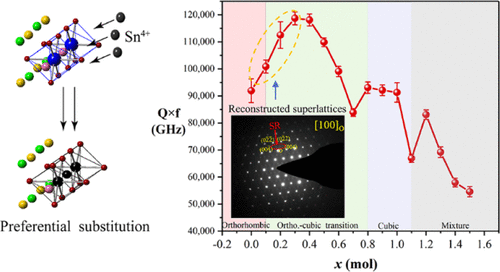当前位置:
X-MOL 学术
›
J. Phys. Chem. C
›
论文详情
Our official English website, www.x-mol.net, welcomes your feedback! (Note: you will need to create a separate account there.)
Effects of Lattice Evolution and Ordering on the Microwave Dielectric Properties of Tin-Modified Li3Mg2NbO6-Based Ceramics
The Journal of Physical Chemistry C ( IF 3.7 ) Pub Date : 2020-09-09 , DOI: 10.1021/acs.jpcc.0c04762 Xing Zhang 1, 2 , Xiao Zhang 3 , Zixuan Fang 1, 2 , Zhe Xiong 1, 2 , Hongyu Yang 1, 2 , Shuren Zhang 1, 2 , Bin Tang 1, 2
The Journal of Physical Chemistry C ( IF 3.7 ) Pub Date : 2020-09-09 , DOI: 10.1021/acs.jpcc.0c04762 Xing Zhang 1, 2 , Xiao Zhang 3 , Zixuan Fang 1, 2 , Zhe Xiong 1, 2 , Hongyu Yang 1, 2 , Shuren Zhang 1, 2 , Bin Tang 1, 2
Affiliation

|
In this contribution, the evolution of the crystal structure and the consequent effects on the microwave dielectric responses of the Sn4+-substituted Li3Mg2–x/3SnxNb1–2x/3O6 (0 ≤ x ≤ 1.5) ceramics were investigated as a function of the doping content. Interestingly, a wide range of solid solution (0 ≤ x ≤ 1.1) was obtained by the complex substitutions of Sn ions, and a composition-driven phase transition from the orthorhombic to cubic phase accompanied by an order–disorder transformation occurring in the range of 0.1 ≤ x ≤ 0.7. During the process of the phase transition, high-resolution transmission electron microscopy images showed the presence of a coherent phase boundary between the orthorhombic and cubic phases, which was formed owing to their similar rock-salt crystal configurations and small mismatches in the subcell–lattice parameters. Besides, the electron diffraction patterns indicated that the specimen with relatively low Sn concentration (x = 0.2) contained reconstructed superlattices. The unique layered structure of the end-member Li3Mg2NbO6 constrained the form of the substitution for the dopant ions, where the nonequivalent ions (Sn4+) were expected to enter into the Nb–Mg–Nb clusters in the Nb-rich layers preferentially, which was likely to be the cause of the formation of the reconstructed superlattices. The substitution-induced superlattices were highly related to the low dielectric loss of the specimens, and a small amount of Sn doping (0 ≤ x ≤ 0.3 mol) also lowered the internal strain of the samples. As the Sn concentration increased from 0 to 0.3, the quality factors (Q × f) were significantly enhanced from 91,700 to 118,700 GHz with the emergence of the reconstructed superlattices and the lowered internal strain.
中文翻译:

晶格演化和有序化对锡改性的Li 3 Mg 2 NbO 6基陶瓷的微波介电性能的影响
在这方面的贡献,该晶体结构的演变和所述Sn的微波介电响应由此产生的效果4+取代李3的Mg 2- X / 3 Sn的X铌1-2 X / 3 ö 6(0≤ X ≤ 1.5)研究陶瓷作为掺杂含量的函数。有趣的是,一个宽范围的固体溶液(0≤的X是由Sn离子的复杂取代,和伴随的范围内发生的有序-无序转变,从斜方晶立方相的组合物驱动的相变获得≤1.1) 0.1≤ X≤0.7。在相变过程中,高分辨率透射电子显微镜图像显示正交相和立方相之间存在相干相界,这是由于它们的相似的盐岩晶体构型和子晶格中小的错配而形成的参数。此外,电子衍射图表明,锡含量相对较低(x = 0.2)的样品含有重建的超晶格。端基Li 3 Mg 2 NbO 6的独特层状结构限制了掺杂离子的取代形式,其中非等价离子(Sn 4+)有望优先进入富Nb层中的Nb-Mg-Nb团簇,这很可能是重建超晶格形成的原因。取代诱导的超晶格是高度相关的样品的低介电损耗,以及少量的Sn掺杂(0≤的X ≤0.3摩尔)也降低样品的内部变形。随着Sn浓度从0增加到0.3,随着重构超晶格的出现和内部应变的降低,品质因数(Q × f)从91,700 GHz显着提高。
更新日期:2020-10-08
中文翻译:

晶格演化和有序化对锡改性的Li 3 Mg 2 NbO 6基陶瓷的微波介电性能的影响
在这方面的贡献,该晶体结构的演变和所述Sn的微波介电响应由此产生的效果4+取代李3的Mg 2- X / 3 Sn的X铌1-2 X / 3 ö 6(0≤ X ≤ 1.5)研究陶瓷作为掺杂含量的函数。有趣的是,一个宽范围的固体溶液(0≤的X是由Sn离子的复杂取代,和伴随的范围内发生的有序-无序转变,从斜方晶立方相的组合物驱动的相变获得≤1.1) 0.1≤ X≤0.7。在相变过程中,高分辨率透射电子显微镜图像显示正交相和立方相之间存在相干相界,这是由于它们的相似的盐岩晶体构型和子晶格中小的错配而形成的参数。此外,电子衍射图表明,锡含量相对较低(x = 0.2)的样品含有重建的超晶格。端基Li 3 Mg 2 NbO 6的独特层状结构限制了掺杂离子的取代形式,其中非等价离子(Sn 4+)有望优先进入富Nb层中的Nb-Mg-Nb团簇,这很可能是重建超晶格形成的原因。取代诱导的超晶格是高度相关的样品的低介电损耗,以及少量的Sn掺杂(0≤的X ≤0.3摩尔)也降低样品的内部变形。随着Sn浓度从0增加到0.3,随着重构超晶格的出现和内部应变的降低,品质因数(Q × f)从91,700 GHz显着提高。


























 京公网安备 11010802027423号
京公网安备 11010802027423号